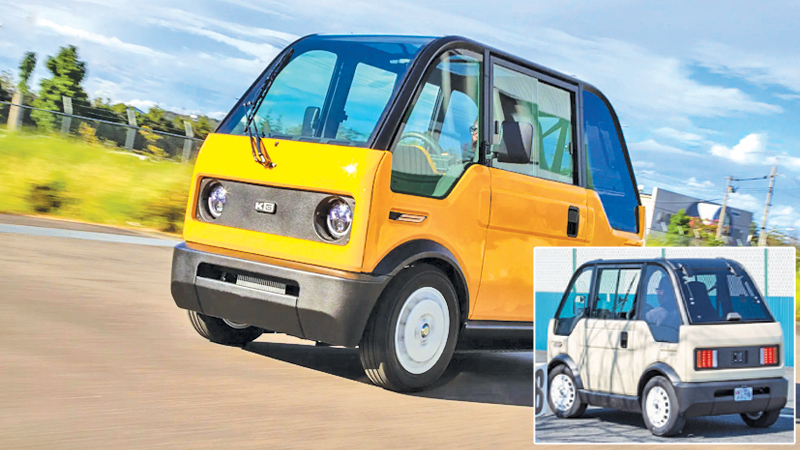In the rural suburbs of Hiroshima, a Japanese startup is trying to kick start the nation’s electric vehicle market with the smallest, cheapest car it can possibly make.
KG Motors has developed a battery-powered one-seater that more resembles a futuristic golf cart than it does a modern Electric Vehicle (EV), much less a traditional car. And yet well over half of the 3,300 units it plans to deliver by March 2027 have already been pre-sold to customers.
Incidentally, that puts it on track to sell more EVs in Japan than the world’s biggest automaker, Toyota, which shifted around such 2,000 vehicles in all of 2024. In a country where EVs are still a rare sight, KG Motors is trying to bust a burgeoning myth: that bigger is better.
“Cars are simply too big,” founder and Chief Executive Officer Kazunari Kusunoki said. “Seeing so many big cars travelling on Japan’s narrow streets – that’s where this all began for me.” At under 1.5 metres in height, KG Motors’ “mibot” has a range of just 100 kilometres, a charging time of five hours and a top speed of 60 kilometres per hour. It will cost ¥1 million (US$ 7,000, LKR 2 million) before taxes when production starts in October at KG Motors’ new factory. That is about half the price of Japan’s most popular EV, Nissan’s Sakura (23,000 cars sold in 2024).
Toyota and its Japanese peers are at odds with other legacy automakers that hold an all-electric view of the future. Toyota has long harboured a multi-pathway approach to a greener tomorrow, one where EVs as well as gasoline, hybrids and hydrogen-powered vehicles play a role. As a result, the gas-electric hybrids pioneered by Japanese manufacturers still dominate.
“Toyota said EVs are not the only solution and, because it is Toyota, Japanese people assume it must be true,” Kusunoki said. “A large number of people in Japan seem to believe EVs won’t become popular.”
Japan, at least, has been slower to embrace the global trend toward larger, roomier vehicles. Smaller autos have always been a feature in the Asian nation and its lightweight Kei cars have even found cult followings abroad. In recent years, they have claimed the lion’s share of the domestic EV market, accounting for 55 percent of total sales in 2023.
In April, BYD said it is planning to produce a fully-electric Kei car specifically for the Japanese market in the second half of 2026, while Hyundai introduced the Inster earlier this year, a ¥ 2.9 million vehicle it claims to be Japan’s cheapest EV, at least among full-sized passenger cars.
Mibot
With its single-seat design, KG Motors’ “mibot” is in a tiny league of its own. The first 300 should be delivered to customers in Hiroshima and Tokyo before the end of next March, while the other 3,000 will be shipped nationwide, Kusunoki said.
KG Motors says it will lose money on the first batch but should break even on the second. After that, the company aims to produce around 10,000 units annually.
The startup’s size and make-to-order strategy could work in its favour. EVs use far less parts than conventional gasoline or hybrid vehicles but the “mibot” takes that to another level, essentially consisting of a battery, motor and sparse electronics connected by wiring housed within a monocoque chassis on four wheels, so production costs are low.
The company has published footage on its website of the car being tested on the icy roads of Hokkaido, squeezing between homes packed into Hiroshima’s historic districts and smashing into concrete walls at high speeds to ensure it satisfies Japan’s strict safety regulations.
Kusunoki, 43, grew up in Higashihiroshima, a suburban town with streets sometimes too narrow even for a Japanese sedan. He watched the country’s public transport infrastructure deteriorate as a shortage of taxi drivers was compounded by an aging, shrinking population.
As young people migrate to big cities, it’s also becoming more difficult for the elderly to get around.
As a result, KG Motors ultimately sees demand for one- or two-seater compact, cost efficient cars. As of early May, the company had received 2,250 orders, with over 95 percent coming from homeowners with at least one vehicle.
“In rural parts of the country, public transportation systems are in shambles,” Kusunoki said. “This might be hard for someone living in Tokyo to understand but at some point, it becomes necessary to have one car per person, not just per household.”
(Bloomberg)









